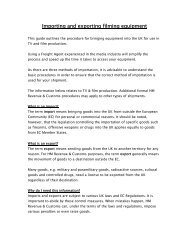Success through diversity and inclusion - BFI - British Film Institute
Success through diversity and inclusion - BFI - British Film Institute
Success through diversity and inclusion - BFI - British Film Institute
You also want an ePaper? Increase the reach of your titles
YUMPU automatically turns print PDFs into web optimized ePapers that Google loves.
22<br />
urban issue, affecting inner city neighbourhoods<br />
<strong>and</strong> urban council estates. The reality is that<br />
people can be socially excluded wherever they<br />
live <strong>and</strong> for a significant minority of rural people,<br />
social exclusion may be a fact of life.<br />
Another way of looking at exclusion is by its<br />
defining characteristics – the habit of nonparticipation,<br />
the habit of isolation <strong>and</strong> a<br />
perceived lack of opportunity <strong>and</strong> choice. In<br />
Scotl<strong>and</strong>, the term used is ‘social justice’.<br />
Recently, the Government has also focused on<br />
‘social cohesion’ or ‘community cohesion’, the<br />
idea of creating a society that is not fractured by<br />
racism, poverty, violence, <strong>and</strong> so on.<br />
Social <strong>inclusion</strong><br />
This can describe the position from which people<br />
can access <strong>and</strong> benefit from the full range of<br />
opportunities available to members of society.<br />
Social <strong>inclusion</strong> is about removing the barriers<br />
<strong>and</strong> factors which lead to exclusion, isolation,<br />
lack of opportunity <strong>and</strong> choice.<br />
Targets<br />
Targets are not quotas. Targets are a numerical<br />
benchmark or goal against which to measure<br />
progress <strong>and</strong> the size of the change needed. The<br />
achievement of targets is not an end in itself.<br />
Whether externally imposed or set from within<br />
the organisation, targets are a mechanism for<br />
concentrating an organisation on milestones<br />
towards the achievement of fair representation.<br />
Targets represent an aspiration, based on the<br />
expected or desired outcome if systems are<br />
equitable. Targets can be expressed as a<br />
minimum percentage, for example, of the<br />
proportion of all new recruits to the work force<br />
of, for example, minority ethnic groups or<br />
disabled people. Targets can also be used to<br />
measure parity of outcomes – such as relative<br />
success rates.<br />
Quotas<br />
A quota is a m<strong>and</strong>atory, fixed numerical goal that<br />
must be satisfied. Some countries operate<br />
quotas as a means of addressing underrepresentation.<br />
Specifically reserving a<br />
proportion of jobs for certain groups of people is<br />
illegal in the UK because achieving them is likely<br />
to involve unlawful (positive) discrimination.

















